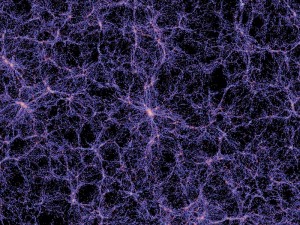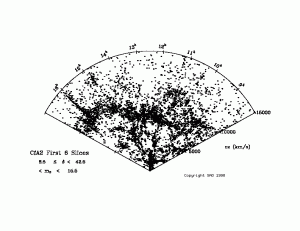
“The universe is what it is, and we’re trying to find out what it is,” John Huchra told me. “The explorers of the new world weren’t trying to prove theories, they were looking at what was out there.”
Huchra was an observational astronomer, as opposed to a theorist. Theorists say that, given physics, the universe ought to look like this. Observers go to telescopes and look, and report back, no, actually it looks like that. Theorists put those observations into a theory and say, then if so, you observers should also see this other thing. Observers look and say, yes but it looks more like that thing. And so on, back and forth, their court, our court, until the whole tennis game – Huchra liked the word, “game” — results in a theory, an explanation, a lovely story we can all believe because it’s so thoroughly grounded in observations.

Huchra died October 8; he’d spent most of his career at the Harvard-Smithsonian Center for Astrophysics, the CfA. He’s most famous for the CfA redshift survey, a map of the northern skies. Sky maps are land maps in three dimensions, the third being distance. Finding galaxies’ distances, measured by what astronomers call “redshift,” meant painstakingly observing each galaxy for 20 minutes to an hour, one by one. In 1972, astronomers had 1,000 redshifts and by then, Huchra had spent enough time observing that he knew, as he said, “I could make telescopes sit up and take data.”
Five years later, he and colleagues began the CfA redshift survey, measuring redshifts with new, speedy technology until 1989, when they had redshifts on 18,000 galaxies and found what no one expected: that galaxies, he wrote, “lay on surfaces surrounding large empty regions,” as though they outlined the surfaces of bubbles. The most spectacular structure, the largest structure anyone had ever seen, was the Great Wall,‘ 600 x 250 x 30 million light years, “sort of like a giant quilt of galaxies across the sky.”
In the twenty years since, new redshift surveys have made the Great Wall look like small potatoes. But the CfA map gave theorists their first shot at accounting for the structure of the universe in a theory that’s both beautiful — and yes, beauty is often a criterion – and believable. “Our maps are beautiful too,” Huchra told me. “They’re striking. People can’t help but look at them. It’s like the data is art.”
At age 61, Huchra died much too soon, and one reason to miss him is that he thought of data as art, of observations as beautiful as they surely are, and that he could think these things because as a young graduate student, he climbed onto a telescope and felt, he said, that “I was home.”
Photo credits:
Theory: The Millenium Simulation
Great Wall: Valerie de Lapparent, Margaret Geller and John Huchra, Smithsonian Astrophysical Observatory